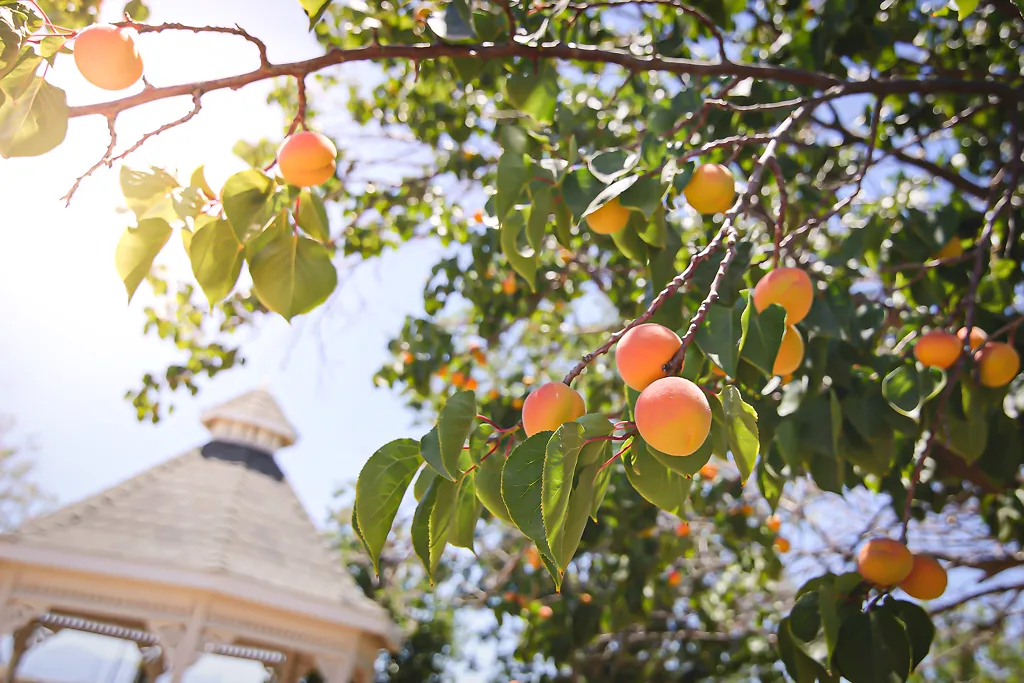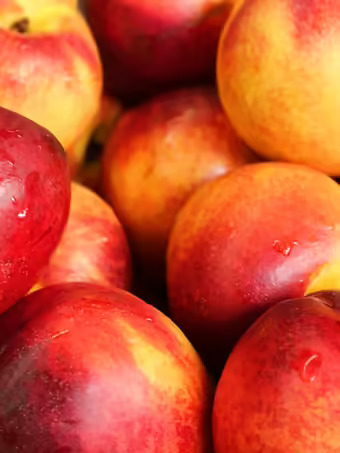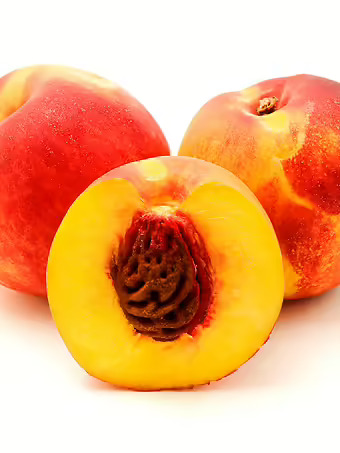Flavortop Nectarine Trees For Sale
Nectarines are a real symbol of the lazy days of summer. Fresh, in pies, with ice-cream, in smoothies or for canning and jam-making, a supply of ripe nectarines makes for a great season and will make the whole family happy. This delicious fruit is actually one of the easier fruits to grow at home and with yields of up to 6 bushels of fruit per tree, the results can be amazing. Once reason for the relative ease of nectarine growing is that they do not require a second-tree as a cross-pollinator, so a single tree can be grown that will produce plenty of fruit for the average family. You just need to choose a sunny spot, make sure your tree has sufficient water, do some simple pruning and in a short time you will be picking luscious ripe nectarines straight from the tree.
The nectarine is really a type of peach, but without that annoying fuzzy skin. So instead of having to peel them you can just pick them off the tree and eat. Since they can be used in all the ways that nectarines can be used, many people who find the nectarine skin a problem choose a nectarine tree rather than a peach tree if they are short of space.
Using Nectarine Trees on Your Property
Nectarine Trees develop into a spreading tree 15 to 25 tall and around 15 feet wide. If you grow a tree on a dwarfing rootstock it will reach around 10 feet only, which is great if you have less room, but the yield will only be around 2 bushels from a smaller tree. Because of the pruning method used, the tree has an open center with spreading branches from which the nectarines hang. So a Nectarine Tree can be used as a shade tree in your back yard, or planted among other trees and large shrubs as part of your general planting. Nectarine Trees can also be trained as a fan on a sunny wall and that way take up no room at all in your garden. This method makes them easy to prune and also to pick from.
What is a Nectarine Tree Like?
Nectarine Trees form an open tree that has dark-green, simple leaves on it, which turn yellow and drop in the fall. The flowers are small, pink and with five petals. They are born singly or in pairs along the branches and appear in spring before the leaves. As well as giving you fruit, a Nectarine Tree in bloom is a beautiful sight that will light up your garden.
The flesh of the nectarine is delicate and easily bruised, which is why commercial nectarine varieties are picked and shipped before they are fully ripe. Unfortunately this robs us of their best flavor, which happens only when the fruit is picked fully ripe. The large stone inside is of course the seed, but growing nectarines from their own seeds is not a good idea as they will not grow up to be like the parent plant, and will take many years to begin to fruit. The resulting fruit will probably be a disappointment. However, a purchased tree will begin to fruit in the third season after planting, so only a little patience is needed before you can begin picking your own juicy nectarines. Nectarines ripen in July and August, depending on the variety and the location in which they are grown.
Types of Nectarine
Nectarines are of two kinds, slipstone and clingstone. The flesh of a slipstone nectarine comes easily and cleanly away from the stone, so this type is easier to work with when preparing pies, desserts or canning. With clingstone nectarines the flesh is harder to remove from the stone, so they are generally not so popular. With each type the nectarine itself can have either yellow flesh or white flesh. White flesh nectarines have largely disappeared, as they were rather bland and not very popular. So a yellow-fleshed, slipstone nectarine is the ideal choice for the home garden, such as the Flavortop Nectarine, which is one of the best overall varieties.
Hardiness and Growing Conditions For Nectarine Trees
Nectarine Trees are generally hardy in zones 5 to 8, so many Americans can grow nectarines in their garden. However there are some other points to consider. Nectarines need a certain number of hours below 450F to develop properly. These are called ‘chilling hours’ and a tree usually needs between 400 and 900 hours depending on the variety. Once they have had the necessary number of hours they are ready to bloom and will begin to do so as soon as the weather becomes a little warmer. However, this leaves them open to damage from late frosts, so in colder areas it is best to choose varieties with the longest chilling hour requirements. A good compromise is to choose an intermediate variety, such as the Flavortop Nectarine, which needs around 700 chilling hours.
Nectarines do best in a sunny location with well-drained, slightly sandy soil. They do not do well in heavy clay soils that stay wet for a long time. They do however need water and are not drought tolerant. The size and quality of the fruit is greatly improved in sufficient water is provided at all times during the growing season. Try to plant your tree on a slope and not in a hollow, as spring frosts tend to gather in low ground, but flow away on a slope. If planted in this way your nectarine tree will have the best chance of surviving a late frost without damage. Smoke from a slow fire, or leaving an overhead sprinkler running are other good ways to provide protection for your tree from a late frost. Nectarine Trees are not entirely pest and disease free and if pests become a problem a control program may be necessary to ensure a good crop.
Planting and Initial Care
Nectarine Trees are grafted onto a hardy root-stock. The position of this join is visible low down on the stem. When planting your nectarine, do not plant deeply and make sure that this union is an inch above the final soil level. Enrich the soil with organic material before planting and water well during the planting process. Water newly planted trees once a week until they become well established.
History and Origins of Nectarine Trees
Nectarine Trees are a kind of peach. It is not entirely clear where they originated, but it is likely that it was in China, where peaches also come from. These early fruits were small, white-fleshed and had green, red or yellow skin. They traveled to Europe via Greece, where the juice was popular and called nektar – meaning ‘drink of the gods’. Six varieties were known in Europe by the 1620’s and it is recorded as being grown in Virginia in 1720. By the 19th century the Spanish had planted them in California. However it was not until the 1940’s when a variety called ‘Le Grande’ was developed (in the town of the same name) with yellow flesh that they became really popular. The Flavortop Nectarine is a distant relative of that first modern variety and has rich yellow flesh with a bright red skin and a delicious flavor.
Long-Term Care
Nectarines need rather more care than some other kinds of fruits. They particularly need plenty of fertilizer and should have ½ a pound of 10-10-10 fertilizer 7 to 10 days after planting and again 40 days later. Spread the fertilizer evenly, 8 to 12 inches away from the trunk. Each following spring, they should be given ¾ of a pound of 10-10-10 in March and again in May. Once your trees are four years old, increase that amount to 1 pound and later to 2 pounds for large, older trees. Spread this over the soil below the branches and keep it well away from the trunk. Organic growers can replace this with 25 lbs. of rotted manure or good compost. From flowering time to harvest, keep your tree well watered.
Pruning should begin immediately after planting. Cut off the center stem 30 inches above the ground – this may already have been done if you buy a larger tree. Remove any branches close to the ground. This cutting will cause several shoots to grow out to form a vase shape, allowing sunshine into the center of the tree and eventually help ripen the fruit. Continue to remove any low-hanging, weak shoots or any shoots that grow into the center and continue to develop an open, vase shape to your tree. The height can be controlled by cutting back tall shoots to an outward-facing bud or shoot. Do not allow your tree to become too crowded with branches as this will reduce the ability of the fruit to ripen properly.








